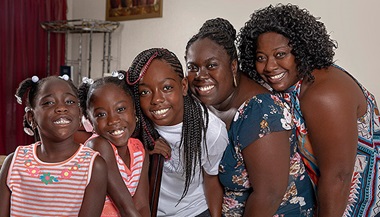Patient Story
Emilie's Story Attracts Record Number of Be the Match Registrants

Just one month before Childhood Cancer Awareness Month, little Emilie rang the symbolic bell on the hematology and oncology floor at Johns Hopkins All Children’s Hospital. The ringing celebration marks the end of chemotherapy treatment.
“Seeing her go through everything was tough on all of us,” says Emilie’s mom, Roxie. “Emilie had good times and very hard times, but we are very grateful that she is now done with that part of her treatment.”
At just nine months old last November, Emilie was taken to Johns Hopkins All Children’s with a high fever where she was diagnosed with acute myeloid leukemia. She would need to undergo chemotherapy and eventually, a bone marrow transplant.
“It was very hard to wrap our head around this,” explains Roxie. “As a parent you feel hopeless, devastated – knowing that your child has to fight for their life is very hard.”
It started with a family friend determined to find Emilie's perfect bone marrow transplant match, and resulted in a record number of bone marrow registrants...4,700 new registrants.
Acute myeloid leukemia is the second most common type of childhood leukemia. During her treatment under the care of Benjamin Oshrine, M.D., she needed three rounds of chemotherapy to get rid of the leukemia in order to receive the bone marrow transplant. The race was on to find the perfect match since the transplant would need to take place within a certain timeframe.
“It takes a considerable amount of time to identify and evaluate potential donors,” explains Dr. Oshrine.
The now one-year-old’s journey caught the attention of media around the country. It started with a family friend determined to find Emilie’s perfect bone marrow transplant match, and resulted in a record number of bone marrow registrants through an online drive for Be The Match, the largest and most diverse donor registry in the world. The link specifically created for Emilie quickly brought in 4,700 new registrants.
“That’s unheard of,” says senior community engagement representative Marc Silver. “That’s never happened in the company.”
Between the online and in-person drives, a total of 9,000 people participated in hopes of helping little Emilie. Silver’s annual goal for the entire state of Florida is 3,300.
“I worked 38 days straight, no days off, 12 to 16 hours every day between passing out kits, processing kits and working drives,” says Silver.
“The outpour of people wanting to help was amazing,” says Roxie.
In the end, Emilie did not find her match, but her bone marrow transplant did move forward with her dad as the donor. Emilie was able to successfully undergo transplant using a half-match because of a newer platform called haploidentical transplantation with post transplant cyclophosphamide.
The outpour of people wanting to help was amazing.
Roxie, Emilie's mother
“We use heavier preventative regimen after the cells are given to prevent graft vs. host disease, which is the primary complication when you give cells from a mismatched donor,” explains Oshrine. “The transplant field has been evolving rapidly and that’s really only possible with ongoing intensive research efforts.”
Emilie was diagnosed with mild GVHD, but Dr. Oshrine says she is responding well to treatment. Now it’s all about time so Emilie’s immune system can fully take root.
With thousands of new registrants now in the Be The Match database, Silver says potential new matches have already been identified. For Roxie, it is touching to know that her daughter’s story will likely help some of the 14,000 patients on the Be The Match transplant list.
Learn more about our Cancer and Blood Disorders Institute at Johns Hopkins All Children’s Hospital.
Emilie's Physician
Treatment Bone Marrow Transplant Program at Johns Hopkins All Children's Hospital
At the Johns Hopkins All Children’s Cancer & Blood Disorders Institute in St. Petersburg, Florida, we’re dedicated to treating children with both rare and common cancers and blood disorders. As one of the first cancer facilities in Florida specifically for children, we have decades of experience treating these complex conditions.




